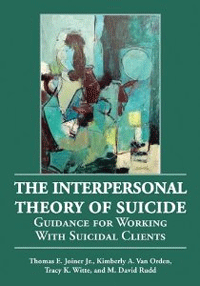The Interpersonal Theory of Suicide: Guidance for Working with Suicidal Clients

“The Interpersonal Theory of Suicide: Guidance for Working with Suicidal Clients”
By Thomas E. Joiner Jr., Kimberly A. Van Orden, Tracy K. Witte, and M. David Rudd
American Psychological Association
Washington, D.C., 2009
Interpersonal theory of suicide outlined in valuable work
Reviewed By James K. Luiselli, Ed.D., ABPP, BCBA-D
Mental health professionals require specialized training to properly assess clients at risk for suicide. Understanding the threat of lethal self-harming behavior, in part, should be based on theories of suicide and respective clinical implications. This book is intended to “demystify clinical work with suicidal patients by grounding this work within a model of suicidal behavior, the interpersonal theory of suicide.”
Accordingly to the authors, the reason people die by suicide is, “Because they can, and because they want to – because they develop both the desire and the capability to do so.” By their own admission a superficial description, they elaborate in great detail an integrative theory that considers concepts labeled “perceived burdensomeness,” “acquired capability” and “failed belongingness.” It is the interaction of these constructs that predicts an attempt at or death by suicide.
After explaining the interpersonal theory of suicide, the authors cover many topics that should educate practicing clinicians. For example, their chapter on diagnosis associated with suicide offers useful information about the influence of co-morbid conditions (depression, bipolar disorder, persistent mental illness). The chapter on risk assessment is particularly good, with examples of suicide screening instruments and a Suicide Risk Assessment Decision Tree. Also impressive is the chapter concerning crisis intervention and recommendations for helping clients recognize risk “triggers,” avoid suicidal thinking and gain access to preventive and emergency care.
Crisis intervention notwithstanding, treatment of clients who are at risk for suicide demands evidence-based psychotherapy that can be applied on an outpatient basis. The book considers several of them, including dialectical behavior therapy, cognitive therapy and motivational interviewing. In addition to describing these and other treatment methods, the authors carefully review how the therapeutic relationship between client and clinician sets the tone for success.
The book devotes a chapter to suicide prevention and public health campaigns, referencing population risk statistics and universal strategies such as limiting access to lethal methods, public awareness via the radio, television and print media, support groups and prevention hotlines. This chapter also focuses on prevention strategies for recent suicide attempters, children and adolescents and older adults.
Whether you understand or accept the interpersonal theory of suicide should not distract from the wisdom contained in this book. I don’t think, for example, that the theory unequivocally informs the types of assessment, treatment and prevention approaches that the authors advocate. However, I strongly endorse their practice recommendations and suggestions for future research. There is much to learn from reading the book and much hope for people facing serious life crises and the professionals responsible for their care.
James K. Luiselli, Ed.D., ABPP, BCBA-D, is senior vice president, applied research, clinical training and peer review at the May Institute in Norwood, Mass.
